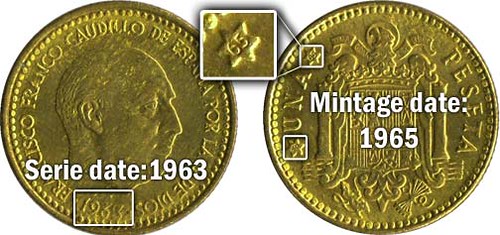
PREV ARTICLE
FULL ISSUE
PREV FULL ISSUE
FEATURED WEB PAGE: DATES ON MODERN SPANISH PESETA COINSThis week's Featured Web Page from the Numista site is about reading the dates on modern Spanish peseta coins. Who knew? Not me!
From 1946 through 1982, the coins of Spain bear two dates, a series date and a mintage date. The series date is often mistaken for the mintage date, and this article was written to correct this misconception. This practice began in 1946 and continued for 35 years. It was only applied to coins of 50 centimos and higher, and never to 5 and 10 centimo coins. The series date represents the date in which that particular type of coin was first minted, and it is the more obvious date on the coin. It is typically (but not always) under the portrait on the obverse of the coin, be it General Francisco Franco or King Juan Carlos I. This date will be 1946, 1947, 1949, 1953, 1957, 1963, 1966, 1975, or 1980. Any change to the coin's design, even minor modifications to the portrait or legend, reset the series date to the contemporary year. If the design remained unchanged, the series date remained fixed as well. For example, the five pesetas coin was minted between 1957 and 1974, but all coins minted during that period bear the series date of 1957. The mintage date represents the year the coin was actually minted, and it is easy to overlook. It appears inscribed inside a six-pointed star that appears typically (but not always) on the reverse of the coin. The numerals of the mintage year are incuse text inside these six-pointed star, the last two digits of the mintage year (such as "68" for 1968). In some series, another star containing the first two digits of the mintage year (always "19") appears as well. In 1982, the design date was retired, and Spanish coins began bearing only the mintage date, though some coins in 1982 still used the older two-date custom. If the coin bears the logo of the Royal Mint of Spain (a crowned letter "M") where the six-pointed star would be, then the date on the obverse is the mintage date.

en.numista.com/numisdoc/dates-on-modern-spanish-peseta-coins-61.htmlWayne Homren, Editor The Numismatic Bibliomania Society is a non-profit organization promoting numismatic literature. See our web site at coinbooks.org. To submit items for publication in The E-Sylum, write to the Editor at this address: whomren@gmail.com To subscribe go to: https://my.binhost.com/lists/listinfo/esylum All Rights Reserved. NBS Home Page Contact the NBS webmaster 
|